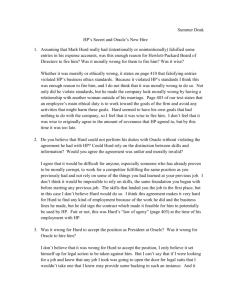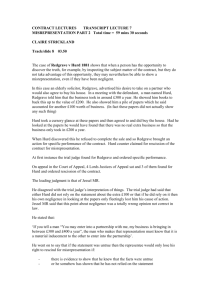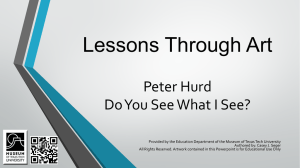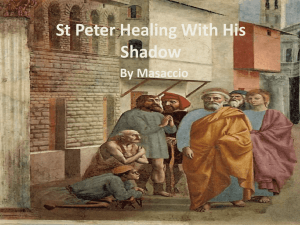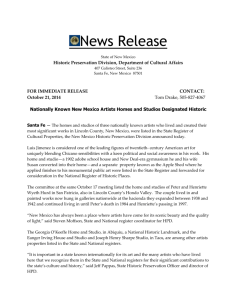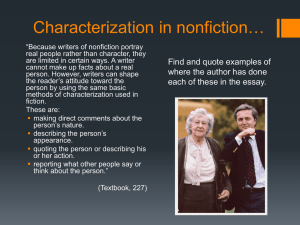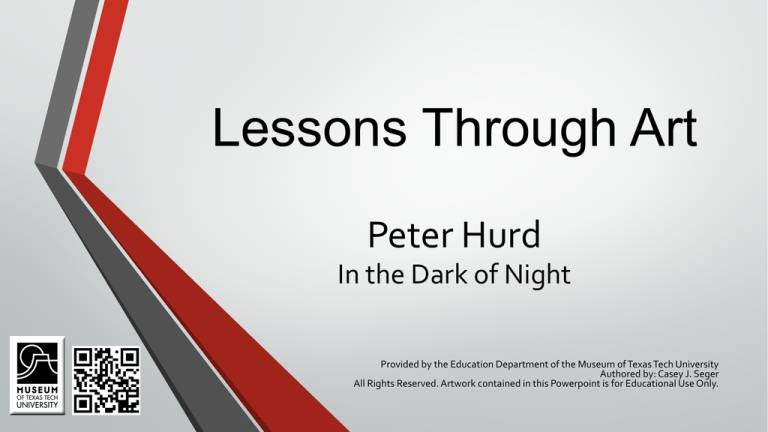
Lessons Through Art Peter Hurd In the Dark of Night Provided by the Education Department of the Museum of Texas Tech University Authored by: Casey J. Seger All Rights Reserved. Artwork contained in this Powerpoint is for Educational Use Only. Emphasis of Presentation • Study Focus: Peter Hurd • Title of Lesson Plan: In the Dark of Night • Grade Level: Grades 3-­‐5 Texas Essential Knowledge and Skills (TEKS) • Fine Arts •
117.11,14,17 •
Response and Evaluation • Technology Applications •
126.7 •
Technology Applications, Grades 3-­‐5 • English Language Arts and Reading •
110.14,15,16 •
•
•
•
Writing/Writing Process Research/Research Plan Research/Organizing and Presenting Ideas Listening and Speaking/Teamwork In the Dark of Night Methods of Evaluation • Class Discussion • Student’s presentation • Evaluation of Student’s writing In the Dark of Night Learning Objectives • Students will enhance writing skills • Students will learn communication skills and practice public speaking. • Students will discuss the painting Moonlight. In the Dark of Night Time Required • Two class periods, each about 45-­‐60 minutes. • One period for artist presentation and discussion • One for presentations and discussion • Class Size: 15-­‐20 • If class size is over 20 students, the lesson can be modified to work with groups instead of individuals. In the Dark of Night Materials Needed • Notebook • Pencil or Pen • Markers • Crayons • Colored pencils • White construction paper • Image of Moonlight by Peter Hurd. In the Dark of Night: Lesson Description • Start with the presentation on Peter Hurd included in this presentation. • After presentation, allow students time to write down their reactions to the painting. Use these questions as starting points: •
•
•
•
•
•
•
•
What do you see when you look at the painting? What do you hear when you look at the painting? What do you feel when you look at the painting? Do you feel cold, warm, alone, safe? Where might this landscape be located? Why might the moonlight be so bright in the painting? Could it be winter and snow reflecting light? Could it be a Full Moon? Do you see anything in the sky? What does the artist try to depict in this painting? What do you think the painting is made of? In the Dark of Night: Lesson Description (cont.) • After the students have written about their reaction to the painting, bring the students together in a group and discuss each of the questions. • Encourage students to draw on personal experiences when talking about the painting. Did they go camping and see a site similar to this one? Does this remind them of standing outside their house at night? In the Dark of Night: Lesson Description (cont.) • After discussion assign students a short paper where they describe a night scene such as Peter Hurd’s Moonlight. • Along with the writing have students also draw the scene they use in their paper on construction paper. • On the assignment due date have each student present their paper to the class along with the scene that they created. Background Information • Peter Hurd was an artist from New Mexico who painted landscapes of the Southwest, along with other subjects. Hurd grew up in Roswell, NM. After three years in a military high school, Hurd enrolled in the United States Military Academy in West Point. However, after a few years he left West Point and began taking classes in art. Hurd studied under Newell Convers Wyeth and spent a lot of his time with the Wyeth family in Chadds Fork, PA. He eventually married N.C. Wyeth’s oldest daughter, Henriette. Hurd returned to New Mexico, settled in at his house in Sentinel Ranch, NM, painting local landscapes, portraits (including one of former President Lyndon B. Johnson) and scenes of ranch life. He died at the age of 80. Today many of his family members still use the Ranch as a place to paint. Peter Hurd Presentation for Students Peter Hurd 1904-­‐1984 Image Source: United States Bureau of Reclamation Peter Hurd • Early Years •
Studies the United States Calvary Drill Manual at the age of eleven and learns from his father how to shoot guns. •
•
Enters New Mexico Military Institute in order to follow a military carrier to please his father. After three years in the New Mexico Military Institute, Hurd enters United States Military Academy at West Point. • 1922 •
While a Cadet at West Point Hurd must make a decision to stay or leave. According to one account when Hurd was deciding on staying or resigning a Major Parker Kalloch said to him, “Mr. Hurd, I will buy that picture to encourage you in your decision. If you feel you cannot remain in the United States Military Academy and become the best officer in the Army, then go out and become the best artist in the United States.” (Horgan, 25) Hurd resigns and Major Kalloch pays $10 for the painting that Hurd was working on at the time. Ten dollars in 1922 would be about $139 in 2013. This was his first sale as a professional artist. Peter Hurd • 1923 • Leaves West Point to study at Haverford College with the intention of completing his formal education. • Leaves Haverford College soon after entering the Pennsylvania Academy of Fine Arts. • During this time, Hurd becomes a friend to, and student of, N.C. Wyeth. • 1929 • Marries painter Henriette Wyeth • Late 1930’s Early 1940’s • Hurd and family move to San Patricio, NM. Peter Hurd • 1940’s • Serves as an illustrator for LIFE Magazine during WWII. (The resulting paintings and sketches can be seen at the Pentagon in Washington, DC.) • Post WWII • Travels to Africa and Asia • Paints a portrait of Lyndon B. Johnson, meant to be the official portrait of President Johnson, but Johnson dismisses the painting, and the ensuing discussion about the painting increases Peter Hurd’s artistic reputation within the United States. • 1984 • Hurd dies at the age of 80 in New Mexico. Peter Hurd Moonlight, 1945 Egg tempera on panel (25 x 30 inches) Gift of Mrs. Roscoe Wilson Collection of the Museum of Texas Tech University All rights reserved. Terms • Tempera-­‐A method of painting using pigments dissolved in an emulsion miscible with water, typically egg yolk. Resources and Bibliographic Materials • Hurd-­‐La Rinconada Gallery and Guest Homes •
•
http://www.wyethartists.com/about-­‐peter/ If link does not work go to www.wyethartists.com and under the Artists tab locate Peter Hurd. • Texas State Historical Association •
Robert Metzger, "HURD, PETER," Handbook of Texas Online (
http://www.tshaonline.org/handbook/online/articles/lu55), accessed July 18, 2013. Published by the Texas State Historical Association. •
If link does not work go to www.tshaonline.org and search “Hurd, Peter” and the page should be first on the search list. • Horgan, Paul. Peter Hurd: A Portrait Sketch From Life. Austin: The University of Texas Press, 1964. • New Mexico Quarterly. New Mexico Artists. Albuquerque: The University of New Mexico Press, 1952.

